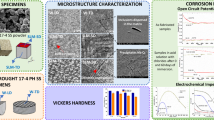The authors present the results of experimental investigations of strength and plasticity characteristics, as well as fracture nature, of the specimens of different steels under tension after ion nitriding in hydrogen (nitrogen with hydrogen) and hydrogen-free (nitrogen with argon) environments. The obtained characteristics are compared with those before nitriding. It is established that during ion nitriding in the hydrogen-free environment, tensile strength of the specimens has increased by 4–11%, whereas relative elongation and contraction have decreased by 1.1–3 times based on the nitriding mode and steel type. The authors have built the tensile stress-strain diagram for the specimens made of steel St3, 40Kh, and 12Kh18N10T without chemical and thermal treatment, ion nitriding in the hydrogen and hydrogen-free environments. The influence of hydrogen concentration in the saturation environment on the strength and plasticity characteristics has been defined. Under concentrations higher than 10 vol.% there is embrittlement with the decrease of strength characteristics (to 15%) and a significant decrease of plasticity (to 40%) for low-alloyed steels. For high-alloyed steels, the negative influence of hydrogen on the strength characteristics does not increase by 3%, while the influence on the plasticity characteristics – by 8%. The authors have investigated the initiation and propagation of microcracks under external loading on the steel with nitride layers.



Similar content being viewed by others
References
G. Alefeld and J. Völkl (Eds.), Hydrogen in Metals I. Basic Properties, II. Application-Oriented Properties, Springer-Verlag, Berlin–Heidelberg (1978).
A. E. Andreikiv, V. V. Panasyuk, and V. S. Kharin, “Theoretical aspects of the kinetics of hydrogen embrittlement,” Fiz.-Khim. Mekh. Mater., No 3, 3–23 (1987).
M. M. Shved, Variation of Operational Properties of Iron and Steel under the Influence of Hydrogen [in Russian], Naukova Dumka, Kiev (1985).
G. V. Karpenko, A. I. Romaniv, and V. I. Tkachev, “Influence of the steel structure on its low-cycle fatigue in hydrogen atmosphere,” Dokl. AN USSR, 214, No. 2, 312–314 (1974).
G. V. Karpenko, M. M. Shved, and I. Ya. Yaremchenko, “On the influence of hydrogenation on the iron strength,” Dokl. AN USSR, 198, No. 3, 651–652 (1971).
O. I. Balyts’kyi, V. M. Mochul’s’kyi, and L. M. Ivas’kevych, “Assessment of the hydrogen effect on the mechanical characteristics of complex alloyed nickel alloy,” Fiz.-Khim. Mekh. Mater., No. 4, 91–100 (2015).
V. I. Pokhmurs’kyi and M. S. Khoma, Corrosion Fatigue of Metals and Alloys [in Ukrainian], Spolom, Lviv (2008).
P. V. Kaplun, O. V. Dykha, and V. A. Gonchar, “Contact life of steel 40Kh in different environments after ion nitriding,” Fiz.-Khim. Mekh. Mater., No. 4, 42–47 (2017).
P. V. Kaplun, “Influence of hydrogen on the contact life of steels during ion nitriding,” Fiz.-Khim. Mekh. Mater., No. 6, 68–72 (2017).
V. V. Panasyuk (Ed.), Fracture Mechanics and Strength of Materials [in Russian], in 4 volumes, Vol. 1: V. V. Panasyuk, A. A. Andreikiv, and V. Z. Parton, Fundamentals of Fracture Mechanics, Naukova Dumka, Kiev (1988).
G. V. Karpenko, Physical and Chemical Mechanics of Structural Metals [in Russian], Naukova Dumka, Kiev (1985).
Yu. I. Archakov, Hydrogen Resistance of Steel [in Russian], Metallurgiya, Moscow (1978).
V. A. Kalachev, Hydrogen Brittleness of Metals [in Russian], Metallurgiya, Moscow (1985).
P. Cotterill, The Hydrogen Embrittlement of Metals, Pergamon Press (1961).
O. I. Balyts’kyi, J. Chmiel, P. Krause, et al., “Role of hydrogen in the cavitation fracture of 45 steel in lubricating media,” Mater. Sci., 45, 651–654 (2009).
A. I. Balitskii and V. V. Panasyuk, “Workability assessment of structural steels of power plant units in hydrogen environments,” Strength Mater., 41, No. 1, 52–57 (2009).
Author information
Authors and Affiliations
Corresponding author
Additional information
Translated from Problemy Prochnosti, No. 3, pp. 86 – 93, May – June, 2020.
Rights and permissions
About this article
Cite this article
Kaplun, P.V., Lyashenko, B.A. Hydrogen Effect on Strength and Plasticity of Steels After Ion Nitriding in Hydrogen and Hydrogen-Free Environments. Strength Mater 52, 407–413 (2020). https://doi.org/10.1007/s11223-020-00191-w
Received:
Published:
Issue Date:
DOI: https://doi.org/10.1007/s11223-020-00191-w




